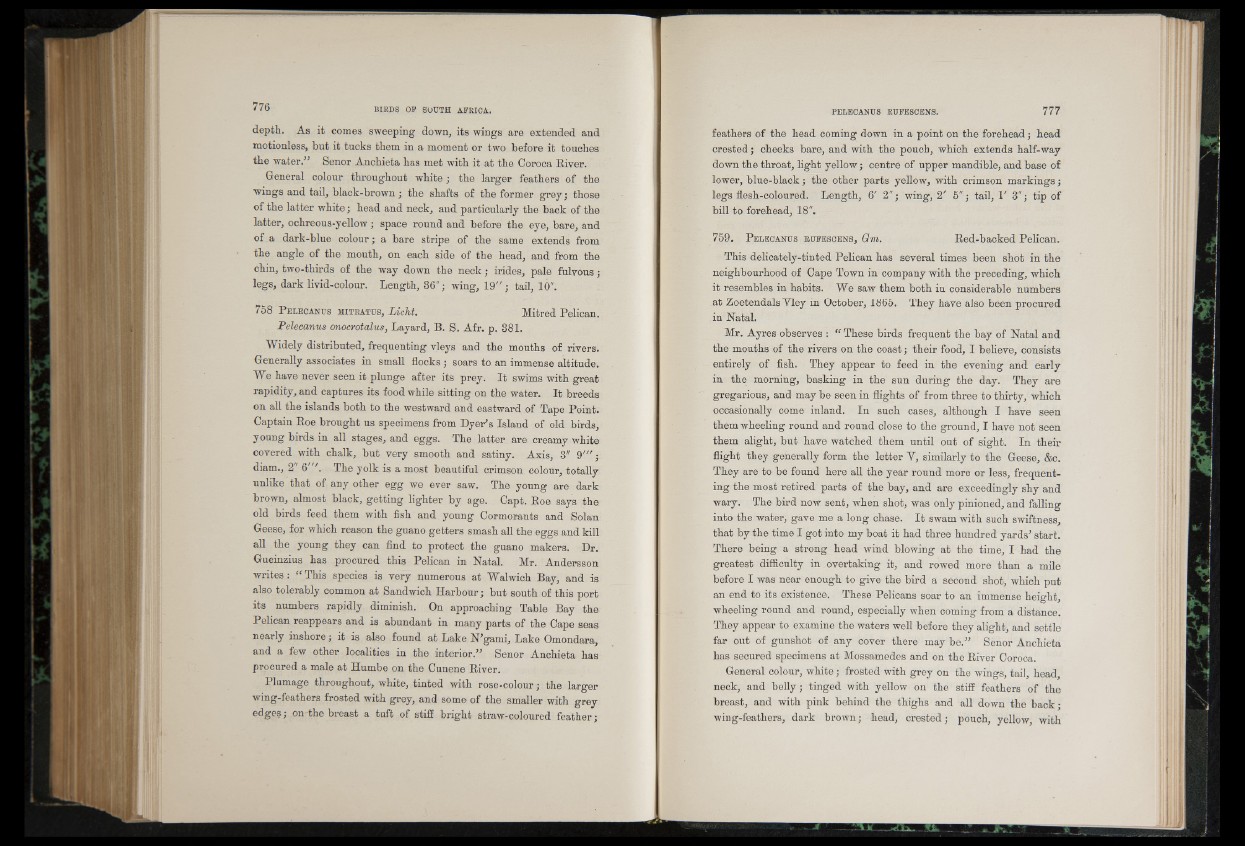
depth. As it comes sweeping down, its wings are extended and
motionless, but it tucks them in a moment or two before it touches
the water.” Senor Anchieta has met with it at the Coroca Eiver.
General colour throughout white ; the larger feathers of the
wings and tail, black-brown ; the shafts of the former grey; those
of the latter white; head and neck, and particularly the back of the
latter, ochreous-yellow ; space round and before the eye, bare, and
of a dark-blue colour; a bare stripe of the same extends from
the angle of the mouth, on each side of the head, and from the
chin, two-thirds of the way down the neck; irides, pale fulvous;
legs, dark livid-colour. Length, 36"; wing, 19"; tail, 10".
758 P el ecanus mitratus, Licht. Mitred Pelican.
Pelecanus onocrotalus, Layard, B. S. Afr. p. 381.
Widely distributed, frequenting vleys and the mouths of rivers.
Generally associates in small flocks ; soars to an immense altitude.
We have never seen it plunge after its prey. It swims with great
rapidity, and captures its food while sitting on the water. It breeds
on all the islands both to the westward and eastward of Tape Point.
Captain Eoe brought us specimens from Dyer’s Island of old birds,
young birds in all stages, and eggs. The latter are creamy white
covered with chalk, but very smooth and satiny. Axis, 3" 9" ';
diam., 2' 6"'. The yolk is a most beautiful crimson colour, totally
unlike that of any other egg we ever saw. The young are dark
brown, almost black, getting lighter by age. Capt. Eoe says the
old birds feed them with fish and young Cormorants and Solan
Geese, for which reason the guano getters smash all the eggs and kill
all the young they can find to protect the guano makers. Dr.
Gueinzius has procured this Pelican in Natal. Mr. Andersson
writes: "This species is very numerous at Walwich Bay, and is
also tolerably common at Sandwich Harbour; but south of this port
its numbers rapidly diminish. On approaching Table Bay the
Pelican reappears and is abundant in many parts of the Cape seas
nearly inshore; it is also found at Lake N’gami, Lake Omondara,
and a few other localities in the interior.” Senor Anchieta has
procured a male at Humbe on the Cunene Eiver.
Plumage throughout, white, tinted with rose-colour; the larger
wmg-feathers frosted with grey, and some of the smaller with grey
edges; on the breast a tuft of stiff bright straw-coloured feather;
feathers of the head coming down in a point on the forehead; head
crested; cheeks bare, and with the pouch, which extends half-way
down the throat, light yellow; centre of upper mandible, and base of
lower, blue-black; the other parts yellow, with crimson markings;
legs flesh-coloured. Length, 6' 2"; wing, 2' 5"; tail, 1' 3"; tip of
bill to forehead, 18".
759. P elecanus ru pe sc en s , Gm. Eed-backed Pelican.
This delicately-tinted Pelican has several times been shot in the
neighbourhood of Cape Town in company with the preceding, which
it resembles in habits. We saw them both in considerable numbers
at Zoetendals Yley in October, 1865. They have also been procured
in Natal.
Mr. Ayres observes : “ These birds frequent the bay of Natal and
the mouths of the rivers on the coast; their food, I believe, consists
entirely of fish. They appear to feed in the evening and early
in the morning, basking in the sun during the day. They are
gregarious, and may be seen in flights of from three to thirty, which
occasionally come inland. In such cases, although I have seen
them wheeling round and round close to the ground, I have not seen
them alight, but have watched them until out of sight. In their
flight they generally form the letter V, similarly to the Geese, &c.
They are to be found here all the year round more or less, frequenting
the most retired parts of the bay, and are exceedingly shy and
wary. The bird now sent, when shot, was only pinioned, and falling
into the water, gave me a long chase. I t swam with such swiftness,
that by the time I got into my boat it had three hundred yards’ start.
There being a strong head wind blowing at the time, I had the
greatest difficulty in overtaking it, and rowed more than a mile
before I was near enough to give the bird a second shot, which put
an end to its existence. These Pelicans soar to an immense height,
wheeling round and round, especially when coming from a distance.
They appear to examine the waters well before they alight, and settle
far out of gunshot of any cover there may be.” Senor Anchieta
has secured specimens at Mossamedes and on the Eiver Coroca.
General colour, white; frosted with grey on the wings, tail, head,
neck, and belly; tinged with yellow on the stiff feathers of the
breast, and with pink behind the thighs and all down the back •
wing-feathers, dark brown; head, crested; pouch, yellow, with